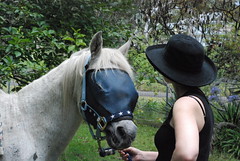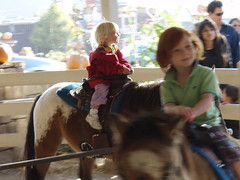Trying to explain riding, real riding, why it matters to me and what it feels like, is like trying to get a firm grip on the flesh of a mango. Rose suggested “exhilarating” the other day, which is correct but incomplete. Swinging on a swing is exhilarating. With riding there is concentration and discipline, work and patience, all layered on top the speed and flight. I tried “internal combustion Zen.”
I cannot, I simply can’t process my luck in having found McIntosh Stables. I trained with Toni back in the day and when I walked into the barn I found that the office manager is another very dear old friend, Beth. I won a Medal round at Creekside on her beautiful Paint horse Austin, who was chewing on his hay in a spotlessly clean stall around the corner. That was one of the two best rides of my life, the other being the stadium round on Wilma the Wonder Pony at the Rancho Murieta 3-day in 2002.
In each case the entire round was complete in my head before I started. I knew the strides into each fence. I knew how the horse would move underneath me, and how I would react. I was outside of time. All I had to do was sit there.
David Murdoch – David the great, my trainer when I had Noah – taught me about cadence. It’s an incredibly powerful and subtle idea in riding, which I don’t completely understand but which I would presently describe as – let’s see.
Horses have cadence naturally, by the way; it’s what makes them beautiful to look at when they move. We describe some horses as being good movers – Noah had spectacular movement, for example, and Alfie had a very fine trot. But we’re splitting hairs there, distinguishing the best of the best, because pretty much any horse moves with the heartbreaking elegance and expressiveness of an inhumanly athletic dancer. Of course they do. Their lives depend upon it.
A good way to understand who horses are, why they are themselves, is to watch them running around at liberty.
Anyway, the idea of cadence in riding is to let the horse move like that even though there’s a rider on its back. (My teachers’ teacher Franz Mairinger wrote an entire book about this.) One of the subconcepts of cadence is “free forward movement,” a term you’ll see over and over again in serious discussions of riding. Movement should not only be forward, although forwardness is extremely important; horse and rider should fearlessly embrace whatever lies ahead. But freedom is also key. There should be no constraint, no blocking, no coercion, no cruelty, no discord, no jarring, only harmony. A horse should flow through you like a river around a stone, like pain. Do you know that trick when you have a broken leg or are in labor, when you forget the last moment and the next one and just let the pain go?
I am digressing again. The damn mango, it is slippery.
To get to this point as a rider you need a lot of very simple and practical techniques – balance, heels down, shoulders back, strong core, quiet leg and hand, loose shoulders, look where you’re going. But you also need a kind of – I grope for and fail to find the words. A stillness in your heart. Goodwill. Trust. Lack of fear. Forgiveness. Absolute patience. Lack of ego. Things are going to go wrong; the horse will evade or baulk, because you are not Alois Podhajsky and you are insufficiently Pure of Heart. Doesn’t matter. Failure, like pain, should run through you moment by moment.
So. Assuming you can be clear and open and perfectly correct yet kind, and give quiet but firm aids for the walk and trot and canter and halt, you create the conditions in which you can ride through cadence. If you don’t actively impede your horse, he or she will find a good rhythm, a free forward gait. This feels wonderful! Your job then is to collect, for shorter, more powerful strides, or extend, for longer, lower strides. Change gears, if you will. A collected canter for going uphill – ie, over a fence. A more extended canter for long straights.
You do this, ideally, by knowing that your horse is going to do it. Truly. I do know how wiggy that sounds. But horses communicate by feel, by gesture, by touch. They express themselves through balance and cadence. You also, though you don’t know it, you monkey with hypergraphia you, you speak through your body and breath.
So if you are on a good horse (and by grace I have been lucky enough to ride some magnificent horses, like Austin, and Alfie, and Noah, and Wilma) the aids for, say, a twenty meter circle include things like looking at the path of the circle. Your horse can feel that your head has turned. Your horse will follow the path you see.
All of which is to give some context to my ride on Cassie yesterday. It was the first time I had ridden seriously in many, many years, but because Cassie is a beautifully trained horse with the temper of an angel, I was able to channel my inner David and my inner Colonel Podhajsky, and ride a 20-meter circle at the canter by looking at where I wanted to go. And then I cantered on the diagonal and looked around the corner and she hopped onto the other lead in a perfect flying change.
The first time she did it I had to pull her up because I was alternately laughing and crying. I can’t ride flying changes! What was my trainer thinking? But every other time I asked her to do it, we nailed it. She gathered herself up in the air and struck off on the other canter lead like being a small Pegasus is no big deal, like her nerdy monkey rider could actually ride. With cadence. She danced for me, a big old Canadian Warmblood mare with a long back and a spiky mane.
I can’t explain even to myself what it is about horses, although I used to try. Why horses? Why me? I had theories of snobbery, but the truth is their horsiness is pretty much the only thing that interests me about the English upper class. I secretly wanted to go to Oxford so someone would invite me to their stately home to go hunting. Next I thought I might have been ruined by books, and one day I will write a great essay on horses in English children’s literature from Enid Bagnold to KM Peyton. But the books were just the intersection of the two great passions of mine, not their source.
The truth is (and you thought I was being wiggy before! Take cover! California in the house!) that when God broke herself into particles of consciousness to run the simulation that is this universe, I got the books and the horses. They’re important to me because they are. I didn’t get opera or Nascar, not in this life. Team sports and languages were, by and large, parcelled out to other people. I got some politics and a fair old dab of science and technology. I got these kids to raise, the best and scariest and happiest job by far. But for comfort and joy, God gave me books and horses.
I can’t thank her enough.





